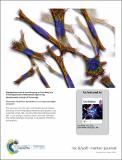Anisotropic mechanics and dynamics of a living mammalian cytoplasm
Author(s)
Gupta, Satish Kumar; Li, Yiwei; Guo, Ming
Downloadc8sm01708e.pdf (3.012Mb)
PUBLISHER_CC
Publisher with Creative Commons License
Creative Commons Attribution
Terms of use
Metadata
Show full item recordAbstract
During physiological processes, cells can undergo morphological changes that can result in a significant redistribution of the cytoskeleton causing anisotropic behavior. Evidence of anisotropy in cells under mechanical stimuli exists; however, the role of cytoskeletal restructuring resulting from changes in cell shape in mechanical anisotropy and its effects remain unclear. In the present study, we examine the role of cell morphology in inducing anisotropy in both intracellular mechanics and dynamics. We change the aspect ratio of cells by confining the cell width and measuring the mechanical properties of the cytoplasm using optical tweezers in both the longitudinal and transverse directions to quantify the degree of mechanical anisotropy. These active microrheology measurements are then combined with intracellular movement to calculate the intracellular force spectrum using force spectrum microscopy (FSM), from which the degree of anisotropy in dynamics and force can be quantified. We find that unrestricted cells with aspect ratio (AR) ∼1 are isotropic; however, when cells break symmetry, they exhibit significant anisotropy in cytoplasmic mechanics and dynamics.
Date issued
2018-11Department
Massachusetts Institute of Technology. Department of Mechanical EngineeringJournal
Soft Matter
Publisher
Royal Society of Chemistry (RSC)
Citation
Gupta, Satish Kumar, Yiwei Li, and Ming Guo. “Anisotropic Mechanics and Dynamics of a Living Mammalian Cytoplasm.” Soft Matter 15, no. 2 (2019): 190–199.
Version: Final published version
ISSN
1744-683X
1744-6848